Oxidation kinetics of speck fat: Insights into its oxidizability and antioxidant efficiency of Salvia officinalis L. and Origanum vulgare L. ethanolic extracts
IF 6.1
1区 农林科学
Q1 Agricultural and Biological Sciences
引用次数: 0
Abstract
This study aimed to determine the oxidizability of speck fat and the efficiency of natural antioxidants extracted from sage (Salvia officinalis L.) and oregano (Origanum vulgare L.) in inhibiting its oxidation using isothermal calorimetry. The rate of radical initiation (Ri) was controlled using azobis(isobutyronitrile) (AIBN) (Ri = 4.0 ± 0.1 × 10−9 M/s) to accurately determine the kinetic parameters. Propagation rate constant (kp) and oxidizability index (O.I.) for speck fat were found to be 6.88 ± 0.08 × 10−3 M-1/2 s-1/2 and 21.77 ± 0.20 M−1 s−1, respectively. In terms of antioxidant efficiency (A.E.), oregano extract exhibited (P < 0.05) greater value compared to sage extract. When compared to synthetic antioxidants, oregano extract did not report significant different A.E. values. Furthermore, the rate constant of inhibition (kinh) for both the extracts was in the order of 103 M−1 s−1. These findings highlight the potential of isothermal calorimetry to determine kinetic parameters from oxidation measurements for solid fats and the role of natural extracts in food preservation.
斑点脂肪的氧化动力学:鼠尾草和鹤耳草乙醇提取物的氧化性和抗氧化效率的研究
采用等温量热法研究鼠尾草和牛至的天然抗氧化剂对斑点脂肪的氧化性及抑制斑点脂肪氧化的作用。采用偶氮(异丁腈)(AIBN)控制自由基起始速率(Ri) (Ri = 4.0±0.1 × 10−9 M/s),准确测定动力学参数。斑点脂肪的繁殖速率常数(kp)和氧化性指数(O.I.)分别为6.88±0.08 × 10−3 M-1/2 s-1/2和21.77±0.20 M−1 s−1。在抗氧化效率(A.E.)方面,牛至提取物表现出(P <;0.05),高于鼠尾草提取物。与合成抗氧化剂相比,牛至提取物的A.E.值没有显著差异。此外,两种提取物的抑制速率常数(kinh)均为103 M−1 s−1。这些发现突出了等温量热法测定固体脂肪氧化动力学参数的潜力,以及天然提取物在食品保存中的作用。
本文章由计算机程序翻译,如有差异,请以英文原文为准。
求助全文
约1分钟内获得全文
求助全文
来源期刊

Meat Science
工程技术-食品科技
CiteScore
12.60
自引率
9.90%
发文量
282
审稿时长
60 days
期刊介绍:
The aim of Meat Science is to serve as a suitable platform for the dissemination of interdisciplinary and international knowledge on all factors influencing the properties of meat. While the journal primarily focuses on the flesh of mammals, contributions related to poultry will be considered if they enhance the overall understanding of the relationship between muscle nature and meat quality post mortem. Additionally, papers on large birds (e.g., emus, ostriches) as well as wild-captured mammals and crocodiles will be welcomed.
 求助内容:
求助内容: 应助结果提醒方式:
应助结果提醒方式:


